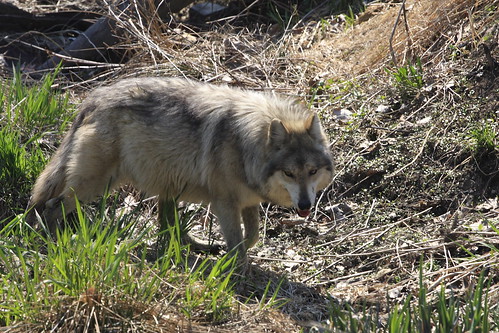A Quick Guide to Wolves
The wolf is seen differently around the world. A wolf is, in some cultures, an evil thing - and is hunted. In other cultures, it is thought of as a spirit that is good to see. And in yet others, wolves are thought of as a good thing, and are hunted for good luck. Wolves are still hunted today in Russia, Europe, and North America. Historically, North American Indians tamed them and used them as guard dogs. Wolves have always fascinated me. They can be found in savannas, taiga, tundra, plains, steppes, and forest. Most of the time when people think of a wolf, they think of some dark shape slinking through the forest, or of a moon outlining a wolf that is howling.

Photo courtesy of flickr creative commons: flickr.com/photos/cryptowolf
Wolves are carnivores. They eat mostly large hoofed creatures, such as moose and elk in the north. But if they can’t find those, gray wolves will hunt anything, from a vole to a bird. When it is cold out they can reduce the blood flow near its skin to conserve body heat, which is important when they live in cold climates, such as Canada and North America. When wolves hunt, they hunt in a pack. Usually one or two herd the prey toward where other wolves (depending on the prey) are hiding, ready to pounce. They use their canine teeth to bite down and hold onto their prey, and afterwards they use their powerful back teeth to scissor meat and tendon off of the bones. They use the same teeth to break open the bones and lick out the marrow. Male gray wolves weigh up to 43 to 45 kg, and this size helps take down their prey. With one pounce, they latch on to the throat of a deer and hang on its back, until it falls.
The gray wolf was once one of the world's most widely distributed mammal, after humans and lions, living throughout the northern hemisphere north of 15°N latitude in North America and 12°N in India. Deliberate human persecution has reduced the species' range to about one third, due to livestock predation and fear over attacks on humans. The species is now extinct in much of Western Europe, in Mexico and much of the USA. In modern times, the gray wolf occurs mostly in wilderness and remote areas, particularly in Canada, Alaska and northern USA, Europe, and Asia from about 75°N to 12°N.
There are a number of places a person can go to see wolves. One of them is Yellowstone National Park. Another is Sweden. I didn’t actually know, when first I started to look into this deeply, that they had grey wolves in Sweden. They have wolves in many places around the world…even in the deserts of Africa.
Nowadays, most people seem to relate to the gray wolf as a mystery. Some people think of werewolves when they think of a wolf, some think of a mindless beast doing all it can to eat them. Some chicken farmers don’t enjoy the wolves because they eat their birds. I don’t think there is any one universal thought about wolves, except if you are walking down a path in the night and you hear a wolf howl in the distance. Then, because at heart we are prey, we cower away. Or at least those who are not informed that a wolf will not usually take out a human. Listen to these wolf howls from Sweden:
Wolves are extremely adaptable. I think that is why I like them. Still, I don’t think I will ever have any because of my sailor nature…and the fact that I don’t approve of taming wolves.
To learn more about wolves, please see:
http://www.wolf.org/wolves/
Gabriel Miller is a member of the Youth Travel Blogging Mentorship Program


















